An Analysis of Sanitarium's Learning and Change Management Practices
VerifiedAdded on 2023/01/16
|12
|2732
|34
Report
AI Summary
This report provides an in-depth analysis of Sanitarium's learning and change management practices. It explores how the company has adapted to changes in customer tastes and lifestyles. The report examines Sanitarium's organisational culture, its commitment to employee engagement, and the impact of its values on its success. The analysis includes the application of the McKinsey 7-S framework to evaluate the company's change efforts, highlighting the importance of shared values, staff, and skills. The report discusses key factors that have influenced outcomes, such as transparency, effective communication, training, and monitoring. It concludes with recommendations for the next phase of learning and change, emphasizing the significance of communication, organisational vision, situational leadership, and incorporating change management models. The report underscores the importance of corporate values, mission, and culture in achieving a competitive edge in the current business environment.

Running head: SANITARIUM LEARNING AND CHANGE MANAGEMENT
1
Sanitarium learning and change management
Name:
Institution:
1
Sanitarium learning and change management
Name:
Institution:
Paraphrase This Document
Need a fresh take? Get an instant paraphrase of this document with our AI Paraphraser

SANITARIUM LEARNING AND CHANGE MANAGEMENT 2
Abstract
Over the last few years, the model of organisational learning has gained a developing
significance, due to sudden transformation in the business climate and advanced competition. It
is evident that businesses that build their learning abilities can enjoy a management advantage in
the business rivalry, and can stay inventive and considerably grow their top and bottom line
returns. This paper discusses organisational learning as a strategic technique for organisation
change. In the state of uncertainty in the environment, continuous engagement in company is
essential. But, most business face resistance to change, hence fail to realise their goals in spite of
exertions. This paper also tries to discuss organisational learning and change with respect to
sanitarium experience in coping with transformation due to customer change in taste, lifestyle,
and preferences. The paper uses McKinsey framework as a change management model to discuss
the importance of the employees and skills in an organisation.
Abstract
Over the last few years, the model of organisational learning has gained a developing
significance, due to sudden transformation in the business climate and advanced competition. It
is evident that businesses that build their learning abilities can enjoy a management advantage in
the business rivalry, and can stay inventive and considerably grow their top and bottom line
returns. This paper discusses organisational learning as a strategic technique for organisation
change. In the state of uncertainty in the environment, continuous engagement in company is
essential. But, most business face resistance to change, hence fail to realise their goals in spite of
exertions. This paper also tries to discuss organisational learning and change with respect to
sanitarium experience in coping with transformation due to customer change in taste, lifestyle,
and preferences. The paper uses McKinsey framework as a change management model to discuss
the importance of the employees and skills in an organisation.
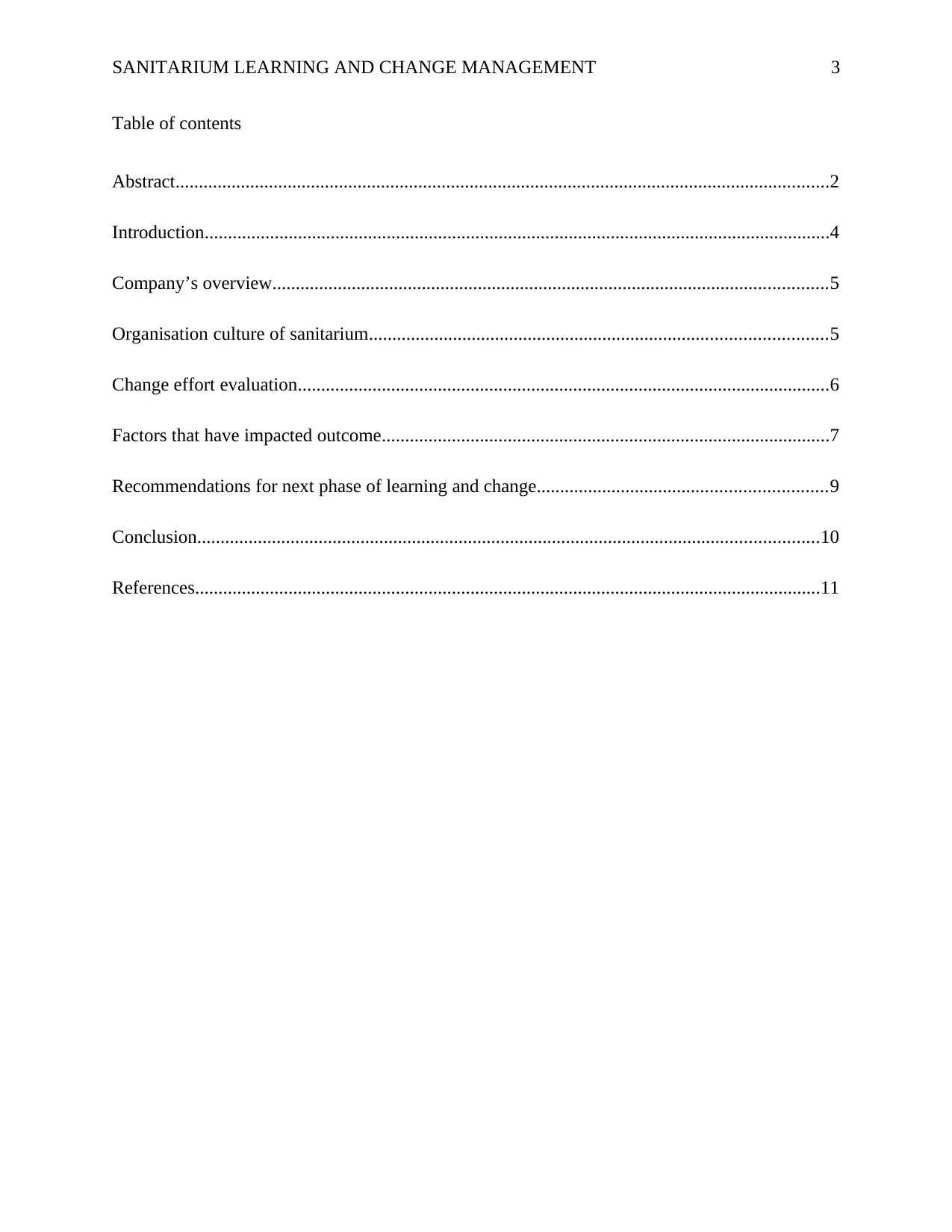
SANITARIUM LEARNING AND CHANGE MANAGEMENT 3
Table of contents
Abstract............................................................................................................................................2
Introduction......................................................................................................................................4
Company’s overview.......................................................................................................................5
Organisation culture of sanitarium..................................................................................................5
Change effort evaluation..................................................................................................................6
Factors that have impacted outcome................................................................................................7
Recommendations for next phase of learning and change..............................................................9
Conclusion.....................................................................................................................................10
References......................................................................................................................................11
Table of contents
Abstract............................................................................................................................................2
Introduction......................................................................................................................................4
Company’s overview.......................................................................................................................5
Organisation culture of sanitarium..................................................................................................5
Change effort evaluation..................................................................................................................6
Factors that have impacted outcome................................................................................................7
Recommendations for next phase of learning and change..............................................................9
Conclusion.....................................................................................................................................10
References......................................................................................................................................11
⊘ This is a preview!⊘
Do you want full access?
Subscribe today to unlock all pages.

Trusted by 1+ million students worldwide

SANITARIUM LEARNING AND CHANGE MANAGEMENT 4
Introduction
In the contemporary world, rapidly changing business environment in the local and
international context of competition have necessitated the corporate to cope with unpredictable
situations through ongoing variations for sustainable growth. Organisational learning assists the
members to lead the transformation to overcome many concerns within and outside the company
and eventually, to realise the business objectives and performances. Given the worth of
organisational learning in communicating various organisational problems, companies still
continue to face the hitches in effectively managing organisational changes (Chikere and Nwoka,
2015, pp. 3). Organisation change process may comprise an uncontrollable situation that means
the employees and organisational needs to depart from routinised work practices and systems
that are sociocultural and that have been accumulated over a long period (Mesquida and Mas,
2015, pp. 83). On the other hand, organisation learning may inhibit successful changes when it
concentrates on exploiting the present competencies and knowledge and regenerating the current
systems, norms, and culture (Dinh et al., 2014, pp. 41). Therefore, a critical task for change agent
is to comprehend the perspective and nature of resistance within organisational learning. This
paper gives an overview of Sanitarium Company and explains how they have managed the
changes coming from vicissitudes in the customer’s tastes, needs and lifestyle.
Company’s overview
Sanitarium is an Australia and New Zealand health food firm that was founded in 1898
(Beech, Maclntosh, Krust, Kannan and Dadich, 2017, pp. 317). The company initiated the launch
of ready-to-eat breakfast cereals, Weet bix, vegan, and peanut butter foodstuffs. The enterprise's
mission is to share with the public a message of well-being and optimism for an improved
existence. Sanitarium vision is to lead, motivate and resource the honest familiarity of healthy,
Introduction
In the contemporary world, rapidly changing business environment in the local and
international context of competition have necessitated the corporate to cope with unpredictable
situations through ongoing variations for sustainable growth. Organisational learning assists the
members to lead the transformation to overcome many concerns within and outside the company
and eventually, to realise the business objectives and performances. Given the worth of
organisational learning in communicating various organisational problems, companies still
continue to face the hitches in effectively managing organisational changes (Chikere and Nwoka,
2015, pp. 3). Organisation change process may comprise an uncontrollable situation that means
the employees and organisational needs to depart from routinised work practices and systems
that are sociocultural and that have been accumulated over a long period (Mesquida and Mas,
2015, pp. 83). On the other hand, organisation learning may inhibit successful changes when it
concentrates on exploiting the present competencies and knowledge and regenerating the current
systems, norms, and culture (Dinh et al., 2014, pp. 41). Therefore, a critical task for change agent
is to comprehend the perspective and nature of resistance within organisational learning. This
paper gives an overview of Sanitarium Company and explains how they have managed the
changes coming from vicissitudes in the customer’s tastes, needs and lifestyle.
Company’s overview
Sanitarium is an Australia and New Zealand health food firm that was founded in 1898
(Beech, Maclntosh, Krust, Kannan and Dadich, 2017, pp. 317). The company initiated the launch
of ready-to-eat breakfast cereals, Weet bix, vegan, and peanut butter foodstuffs. The enterprise's
mission is to share with the public a message of well-being and optimism for an improved
existence. Sanitarium vision is to lead, motivate and resource the honest familiarity of healthy,
Paraphrase This Document
Need a fresh take? Get an instant paraphrase of this document with our AI Paraphraser

SANITARIUM LEARNING AND CHANGE MANAGEMENT 5
and happy existing within the society (Beech et al., 2017, pp. 317). The company core value to
direct the behaviour of its workforce is care, humility, bravery, passion, and honesty. In recent
years, the company has faced the growing variations within the markets, driven by a change in
user taste, needs and lifestyles. In 2012, the company became a beverages-centred, rather than a
cereals-grounded. In spite of external variations and forces, the corporation has persisted to its
mission, vision, and values and has safeguarded the shape of its culture and expected staff
behaviour. The company views its shared culture as the motivator of action (Beech et al., 2017,
pp. 318).
Organisation culture of sanitarium
At the corporation, there is commitment and mutual purpose of making positive and
actual differences in the community. Every employee contributes to the firm’s mission of sharing
hope and health, and this philosophy is what drives a positive connection and power across the
business. Since 2010, the company has developed a culture that deliberate on its true worth and
enduring mission. It has made it to remain relevant in a challenging and competitive fast moving
user industry. Under the management of Hartnett, positive culture demanded everyone to have
responsibility beginning with the front leaders (Beech et al., 2017, pp. 317).
In 2011, the company introduced the Organisational Culture Inventory and Organisation
Effectiveness Inventory to ensure there was a flawless connection between the corporation
values and what it measures (Beech et al., 2017, pp. 317). A new role of culture coach was
initiated across the enterprise, and personnel was drilled to champion the survey and support the
organisation change effectively. At the organisation, leaders played a significant role in
connecting the workforces. The connection was backed through several initiatives, comprising
an annual team talk, teaching groups, leadership, and culture debriefs. The company established
and happy existing within the society (Beech et al., 2017, pp. 317). The company core value to
direct the behaviour of its workforce is care, humility, bravery, passion, and honesty. In recent
years, the company has faced the growing variations within the markets, driven by a change in
user taste, needs and lifestyles. In 2012, the company became a beverages-centred, rather than a
cereals-grounded. In spite of external variations and forces, the corporation has persisted to its
mission, vision, and values and has safeguarded the shape of its culture and expected staff
behaviour. The company views its shared culture as the motivator of action (Beech et al., 2017,
pp. 318).
Organisation culture of sanitarium
At the corporation, there is commitment and mutual purpose of making positive and
actual differences in the community. Every employee contributes to the firm’s mission of sharing
hope and health, and this philosophy is what drives a positive connection and power across the
business. Since 2010, the company has developed a culture that deliberate on its true worth and
enduring mission. It has made it to remain relevant in a challenging and competitive fast moving
user industry. Under the management of Hartnett, positive culture demanded everyone to have
responsibility beginning with the front leaders (Beech et al., 2017, pp. 317).
In 2011, the company introduced the Organisational Culture Inventory and Organisation
Effectiveness Inventory to ensure there was a flawless connection between the corporation
values and what it measures (Beech et al., 2017, pp. 317). A new role of culture coach was
initiated across the enterprise, and personnel was drilled to champion the survey and support the
organisation change effectively. At the organisation, leaders played a significant role in
connecting the workforces. The connection was backed through several initiatives, comprising
an annual team talk, teaching groups, leadership, and culture debriefs. The company established
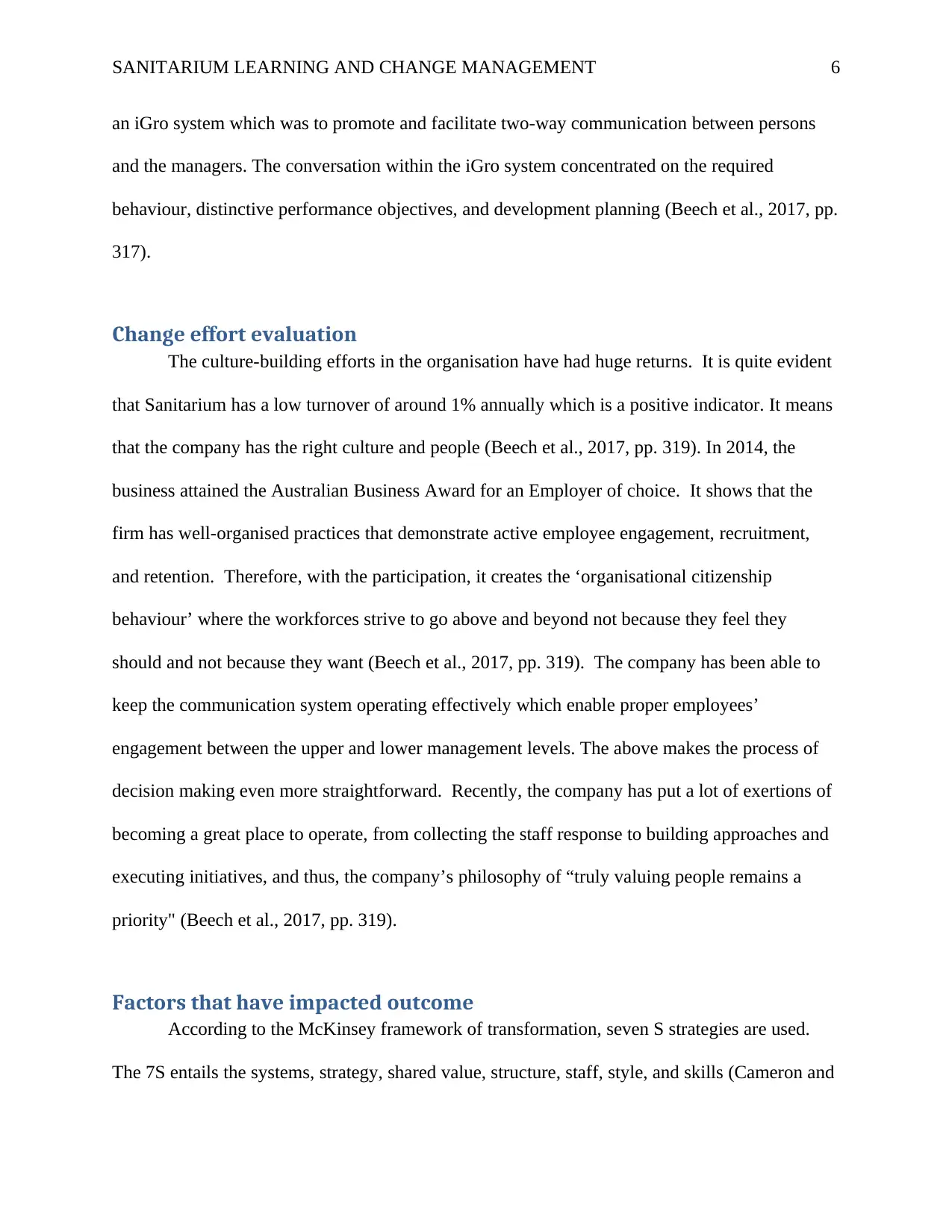
SANITARIUM LEARNING AND CHANGE MANAGEMENT 6
an iGro system which was to promote and facilitate two-way communication between persons
and the managers. The conversation within the iGro system concentrated on the required
behaviour, distinctive performance objectives, and development planning (Beech et al., 2017, pp.
317).
Change effort evaluation
The culture-building efforts in the organisation have had huge returns. It is quite evident
that Sanitarium has a low turnover of around 1% annually which is a positive indicator. It means
that the company has the right culture and people (Beech et al., 2017, pp. 319). In 2014, the
business attained the Australian Business Award for an Employer of choice. It shows that the
firm has well-organised practices that demonstrate active employee engagement, recruitment,
and retention. Therefore, with the participation, it creates the ‘organisational citizenship
behaviour’ where the workforces strive to go above and beyond not because they feel they
should and not because they want (Beech et al., 2017, pp. 319). The company has been able to
keep the communication system operating effectively which enable proper employees’
engagement between the upper and lower management levels. The above makes the process of
decision making even more straightforward. Recently, the company has put a lot of exertions of
becoming a great place to operate, from collecting the staff response to building approaches and
executing initiatives, and thus, the company’s philosophy of “truly valuing people remains a
priority" (Beech et al., 2017, pp. 319).
Factors that have impacted outcome
According to the McKinsey framework of transformation, seven S strategies are used.
The 7S entails the systems, strategy, shared value, structure, staff, style, and skills (Cameron and
an iGro system which was to promote and facilitate two-way communication between persons
and the managers. The conversation within the iGro system concentrated on the required
behaviour, distinctive performance objectives, and development planning (Beech et al., 2017, pp.
317).
Change effort evaluation
The culture-building efforts in the organisation have had huge returns. It is quite evident
that Sanitarium has a low turnover of around 1% annually which is a positive indicator. It means
that the company has the right culture and people (Beech et al., 2017, pp. 319). In 2014, the
business attained the Australian Business Award for an Employer of choice. It shows that the
firm has well-organised practices that demonstrate active employee engagement, recruitment,
and retention. Therefore, with the participation, it creates the ‘organisational citizenship
behaviour’ where the workforces strive to go above and beyond not because they feel they
should and not because they want (Beech et al., 2017, pp. 319). The company has been able to
keep the communication system operating effectively which enable proper employees’
engagement between the upper and lower management levels. The above makes the process of
decision making even more straightforward. Recently, the company has put a lot of exertions of
becoming a great place to operate, from collecting the staff response to building approaches and
executing initiatives, and thus, the company’s philosophy of “truly valuing people remains a
priority" (Beech et al., 2017, pp. 319).
Factors that have impacted outcome
According to the McKinsey framework of transformation, seven S strategies are used.
The 7S entails the systems, strategy, shared value, structure, staff, style, and skills (Cameron and
⊘ This is a preview!⊘
Do you want full access?
Subscribe today to unlock all pages.

Trusted by 1+ million students worldwide
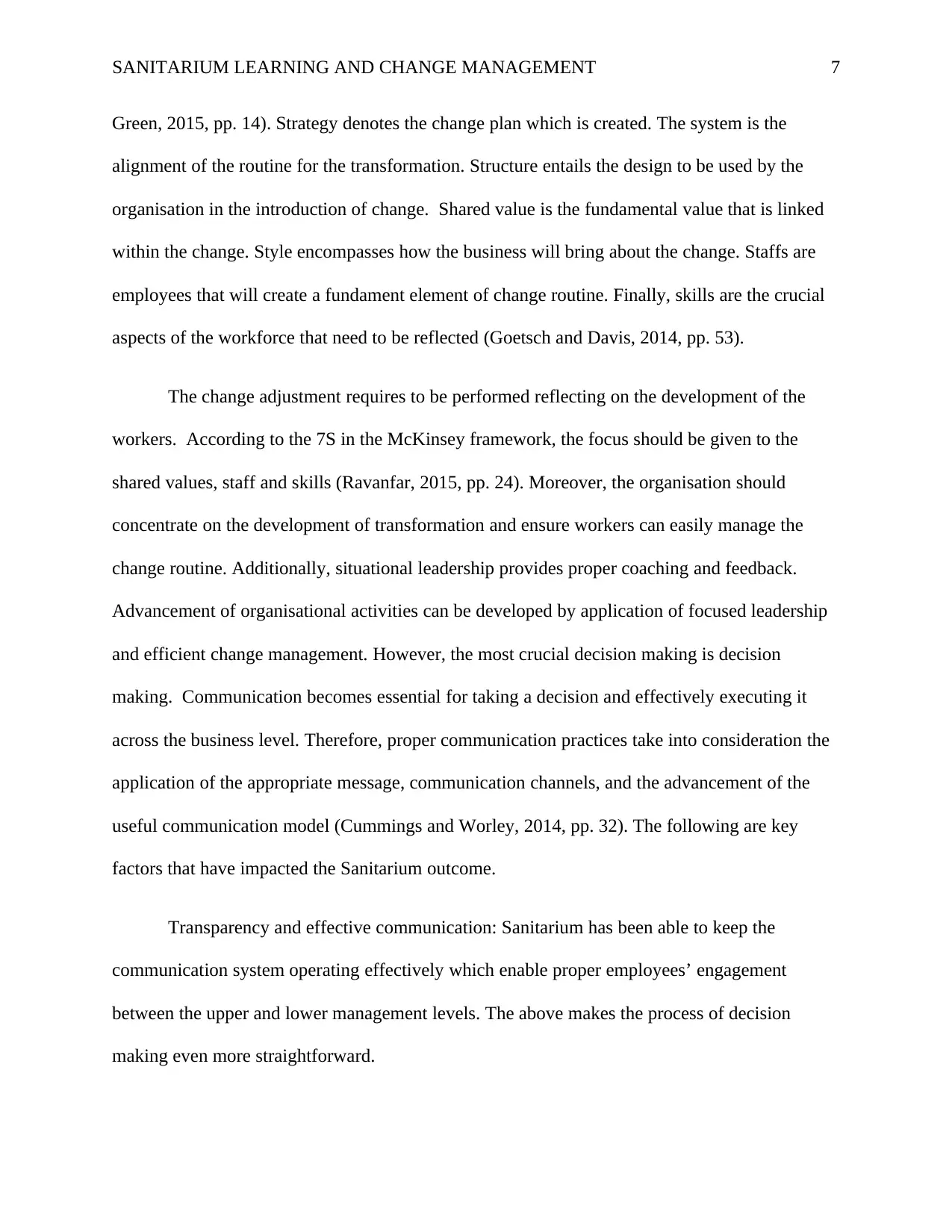
SANITARIUM LEARNING AND CHANGE MANAGEMENT 7
Green, 2015, pp. 14). Strategy denotes the change plan which is created. The system is the
alignment of the routine for the transformation. Structure entails the design to be used by the
organisation in the introduction of change. Shared value is the fundamental value that is linked
within the change. Style encompasses how the business will bring about the change. Staffs are
employees that will create a fundament element of change routine. Finally, skills are the crucial
aspects of the workforce that need to be reflected (Goetsch and Davis, 2014, pp. 53).
The change adjustment requires to be performed reflecting on the development of the
workers. According to the 7S in the McKinsey framework, the focus should be given to the
shared values, staff and skills (Ravanfar, 2015, pp. 24). Moreover, the organisation should
concentrate on the development of transformation and ensure workers can easily manage the
change routine. Additionally, situational leadership provides proper coaching and feedback.
Advancement of organisational activities can be developed by application of focused leadership
and efficient change management. However, the most crucial decision making is decision
making. Communication becomes essential for taking a decision and effectively executing it
across the business level. Therefore, proper communication practices take into consideration the
application of the appropriate message, communication channels, and the advancement of the
useful communication model (Cummings and Worley, 2014, pp. 32). The following are key
factors that have impacted the Sanitarium outcome.
Transparency and effective communication: Sanitarium has been able to keep the
communication system operating effectively which enable proper employees’ engagement
between the upper and lower management levels. The above makes the process of decision
making even more straightforward.
Green, 2015, pp. 14). Strategy denotes the change plan which is created. The system is the
alignment of the routine for the transformation. Structure entails the design to be used by the
organisation in the introduction of change. Shared value is the fundamental value that is linked
within the change. Style encompasses how the business will bring about the change. Staffs are
employees that will create a fundament element of change routine. Finally, skills are the crucial
aspects of the workforce that need to be reflected (Goetsch and Davis, 2014, pp. 53).
The change adjustment requires to be performed reflecting on the development of the
workers. According to the 7S in the McKinsey framework, the focus should be given to the
shared values, staff and skills (Ravanfar, 2015, pp. 24). Moreover, the organisation should
concentrate on the development of transformation and ensure workers can easily manage the
change routine. Additionally, situational leadership provides proper coaching and feedback.
Advancement of organisational activities can be developed by application of focused leadership
and efficient change management. However, the most crucial decision making is decision
making. Communication becomes essential for taking a decision and effectively executing it
across the business level. Therefore, proper communication practices take into consideration the
application of the appropriate message, communication channels, and the advancement of the
useful communication model (Cummings and Worley, 2014, pp. 32). The following are key
factors that have impacted the Sanitarium outcome.
Transparency and effective communication: Sanitarium has been able to keep the
communication system operating effectively which enable proper employees’ engagement
between the upper and lower management levels. The above makes the process of decision
making even more straightforward.
Paraphrase This Document
Need a fresh take? Get an instant paraphrase of this document with our AI Paraphraser
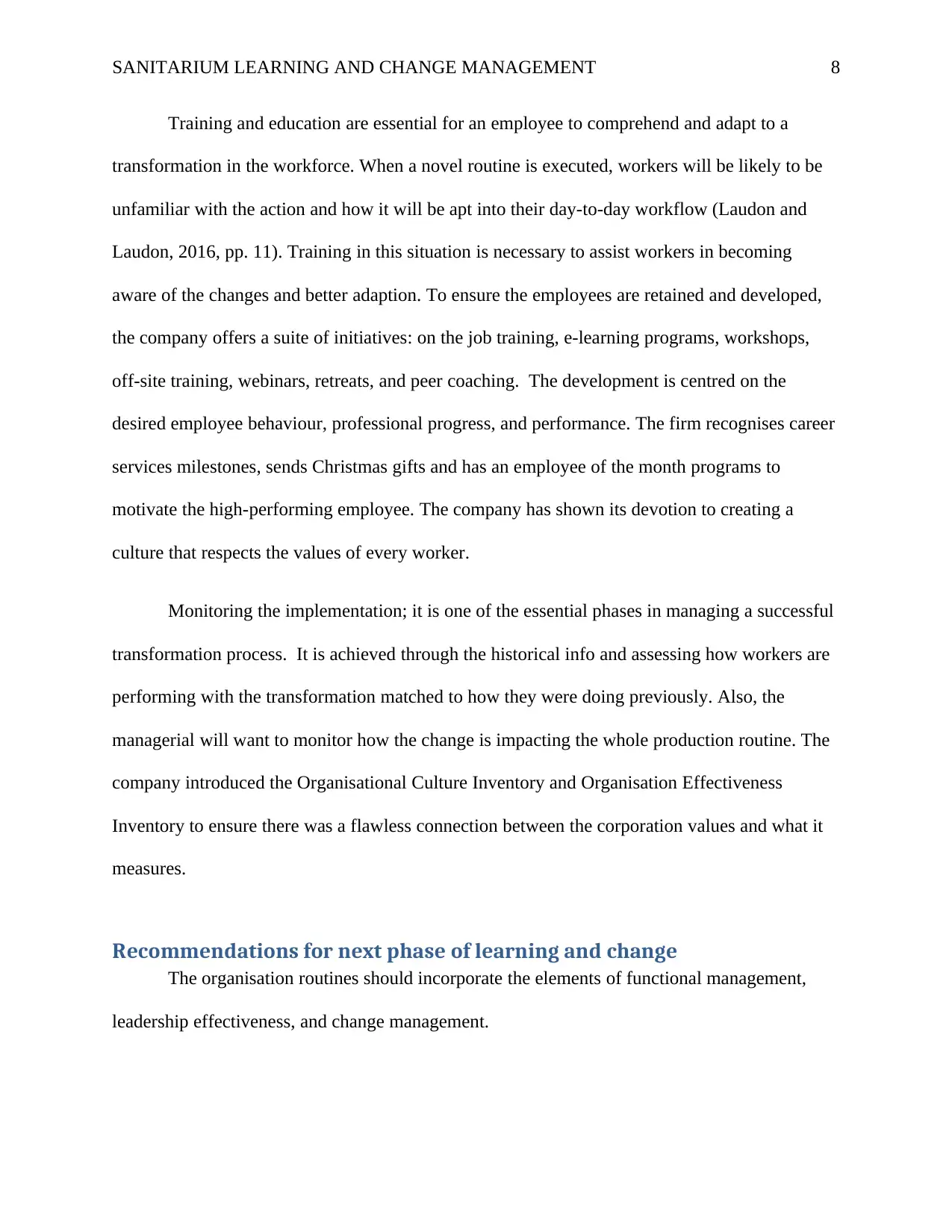
SANITARIUM LEARNING AND CHANGE MANAGEMENT 8
Training and education are essential for an employee to comprehend and adapt to a
transformation in the workforce. When a novel routine is executed, workers will be likely to be
unfamiliar with the action and how it will be apt into their day-to-day workflow (Laudon and
Laudon, 2016, pp. 11). Training in this situation is necessary to assist workers in becoming
aware of the changes and better adaption. To ensure the employees are retained and developed,
the company offers a suite of initiatives: on the job training, e-learning programs, workshops,
off-site training, webinars, retreats, and peer coaching. The development is centred on the
desired employee behaviour, professional progress, and performance. The firm recognises career
services milestones, sends Christmas gifts and has an employee of the month programs to
motivate the high-performing employee. The company has shown its devotion to creating a
culture that respects the values of every worker.
Monitoring the implementation; it is one of the essential phases in managing a successful
transformation process. It is achieved through the historical info and assessing how workers are
performing with the transformation matched to how they were doing previously. Also, the
managerial will want to monitor how the change is impacting the whole production routine. The
company introduced the Organisational Culture Inventory and Organisation Effectiveness
Inventory to ensure there was a flawless connection between the corporation values and what it
measures.
Recommendations for next phase of learning and change
The organisation routines should incorporate the elements of functional management,
leadership effectiveness, and change management.
Training and education are essential for an employee to comprehend and adapt to a
transformation in the workforce. When a novel routine is executed, workers will be likely to be
unfamiliar with the action and how it will be apt into their day-to-day workflow (Laudon and
Laudon, 2016, pp. 11). Training in this situation is necessary to assist workers in becoming
aware of the changes and better adaption. To ensure the employees are retained and developed,
the company offers a suite of initiatives: on the job training, e-learning programs, workshops,
off-site training, webinars, retreats, and peer coaching. The development is centred on the
desired employee behaviour, professional progress, and performance. The firm recognises career
services milestones, sends Christmas gifts and has an employee of the month programs to
motivate the high-performing employee. The company has shown its devotion to creating a
culture that respects the values of every worker.
Monitoring the implementation; it is one of the essential phases in managing a successful
transformation process. It is achieved through the historical info and assessing how workers are
performing with the transformation matched to how they were doing previously. Also, the
managerial will want to monitor how the change is impacting the whole production routine. The
company introduced the Organisational Culture Inventory and Organisation Effectiveness
Inventory to ensure there was a flawless connection between the corporation values and what it
measures.
Recommendations for next phase of learning and change
The organisation routines should incorporate the elements of functional management,
leadership effectiveness, and change management.

SANITARIUM LEARNING AND CHANGE MANAGEMENT 9
Communication is an essential aspect for taking a decision and effectively executing it
across the business levels. Therefore, it is key factor in the next learning and change process
(Palacios-Marqués, Soto-Acosta and Merigó, 2015, pp. 25).
Organizational vision & mission should still be reflected as they offer a sense of drive or
institute the aim for the existence.
The organisation should still focus on more productivity as well as the development of
employees as the situational leadership necessitates more coaching and feedback.
Leadership, innovation, organisation, and corporate social responsibility aspects should
be taken care as they are essential in the context of the organisation learning and change
management (Palmer, Dunford and Akin, 2016, pp. 21).
The management should incorporate various change management model such as
McKinsey framework and Lewin concept to introduce change in an organisation.
Personal counselling: when a major transformation occurs in the workstation, some
employee mays feel very uncomfortable above the change, particularly the workers most
affected by the change. Therefore, next phase should have programs, most likely through HR, to
assist them to embrace change.
Conclusion
Due to unpredictable nature, competitive and highly dynamic environment, changes are
inevitable and a requirement for the business. Companies, therefore, has to be more focused on
maximising their effectiveness in regards to their essential objectives. It can be established that
change management can be enhanced and executed through the use of better leadership. It is
Communication is an essential aspect for taking a decision and effectively executing it
across the business levels. Therefore, it is key factor in the next learning and change process
(Palacios-Marqués, Soto-Acosta and Merigó, 2015, pp. 25).
Organizational vision & mission should still be reflected as they offer a sense of drive or
institute the aim for the existence.
The organisation should still focus on more productivity as well as the development of
employees as the situational leadership necessitates more coaching and feedback.
Leadership, innovation, organisation, and corporate social responsibility aspects should
be taken care as they are essential in the context of the organisation learning and change
management (Palmer, Dunford and Akin, 2016, pp. 21).
The management should incorporate various change management model such as
McKinsey framework and Lewin concept to introduce change in an organisation.
Personal counselling: when a major transformation occurs in the workstation, some
employee mays feel very uncomfortable above the change, particularly the workers most
affected by the change. Therefore, next phase should have programs, most likely through HR, to
assist them to embrace change.
Conclusion
Due to unpredictable nature, competitive and highly dynamic environment, changes are
inevitable and a requirement for the business. Companies, therefore, has to be more focused on
maximising their effectiveness in regards to their essential objectives. It can be established that
change management can be enhanced and executed through the use of better leadership. It is
⊘ This is a preview!⊘
Do you want full access?
Subscribe today to unlock all pages.

Trusted by 1+ million students worldwide
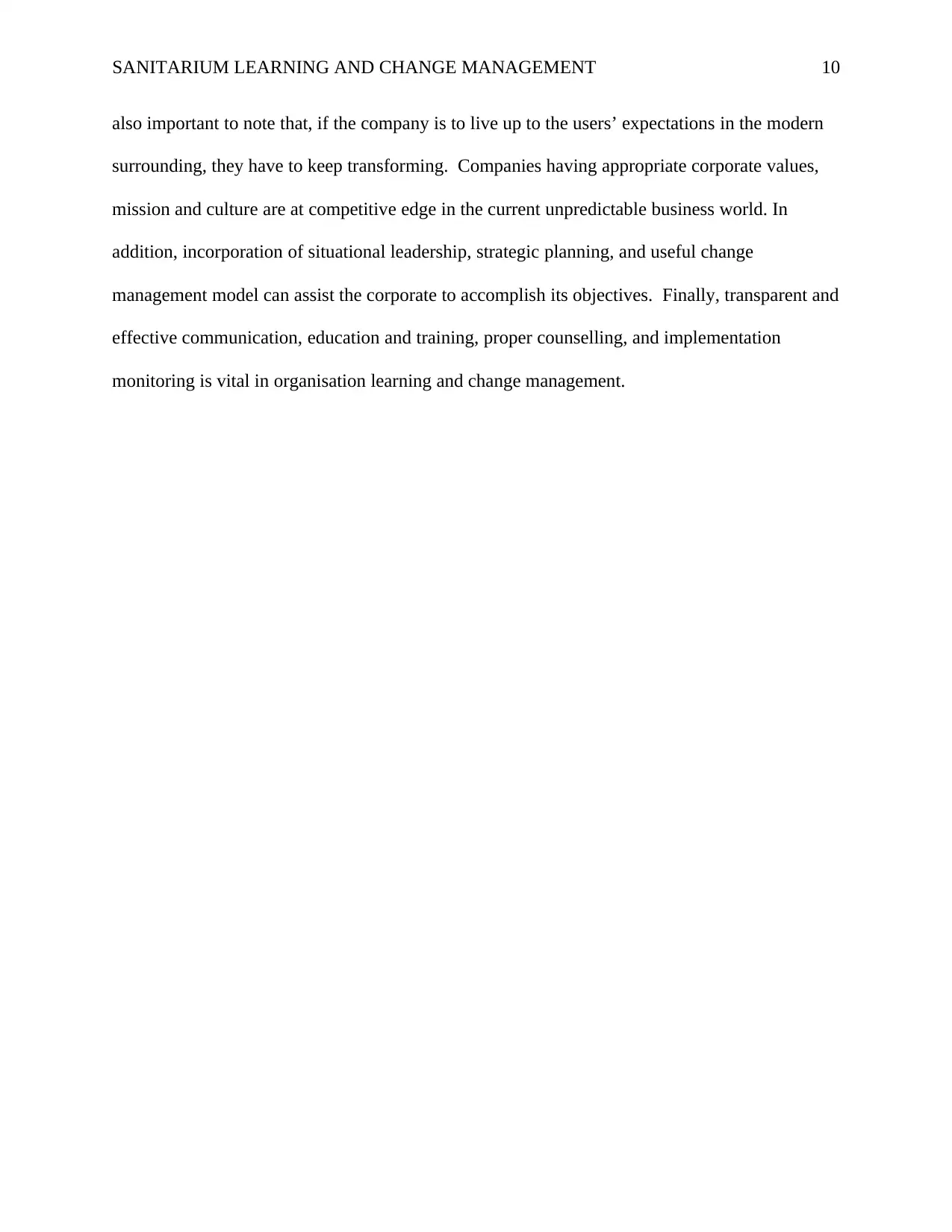
SANITARIUM LEARNING AND CHANGE MANAGEMENT 10
also important to note that, if the company is to live up to the users’ expectations in the modern
surrounding, they have to keep transforming. Companies having appropriate corporate values,
mission and culture are at competitive edge in the current unpredictable business world. In
addition, incorporation of situational leadership, strategic planning, and useful change
management model can assist the corporate to accomplish its objectives. Finally, transparent and
effective communication, education and training, proper counselling, and implementation
monitoring is vital in organisation learning and change management.
also important to note that, if the company is to live up to the users’ expectations in the modern
surrounding, they have to keep transforming. Companies having appropriate corporate values,
mission and culture are at competitive edge in the current unpredictable business world. In
addition, incorporation of situational leadership, strategic planning, and useful change
management model can assist the corporate to accomplish its objectives. Finally, transparent and
effective communication, education and training, proper counselling, and implementation
monitoring is vital in organisation learning and change management.
Paraphrase This Document
Need a fresh take? Get an instant paraphrase of this document with our AI Paraphraser
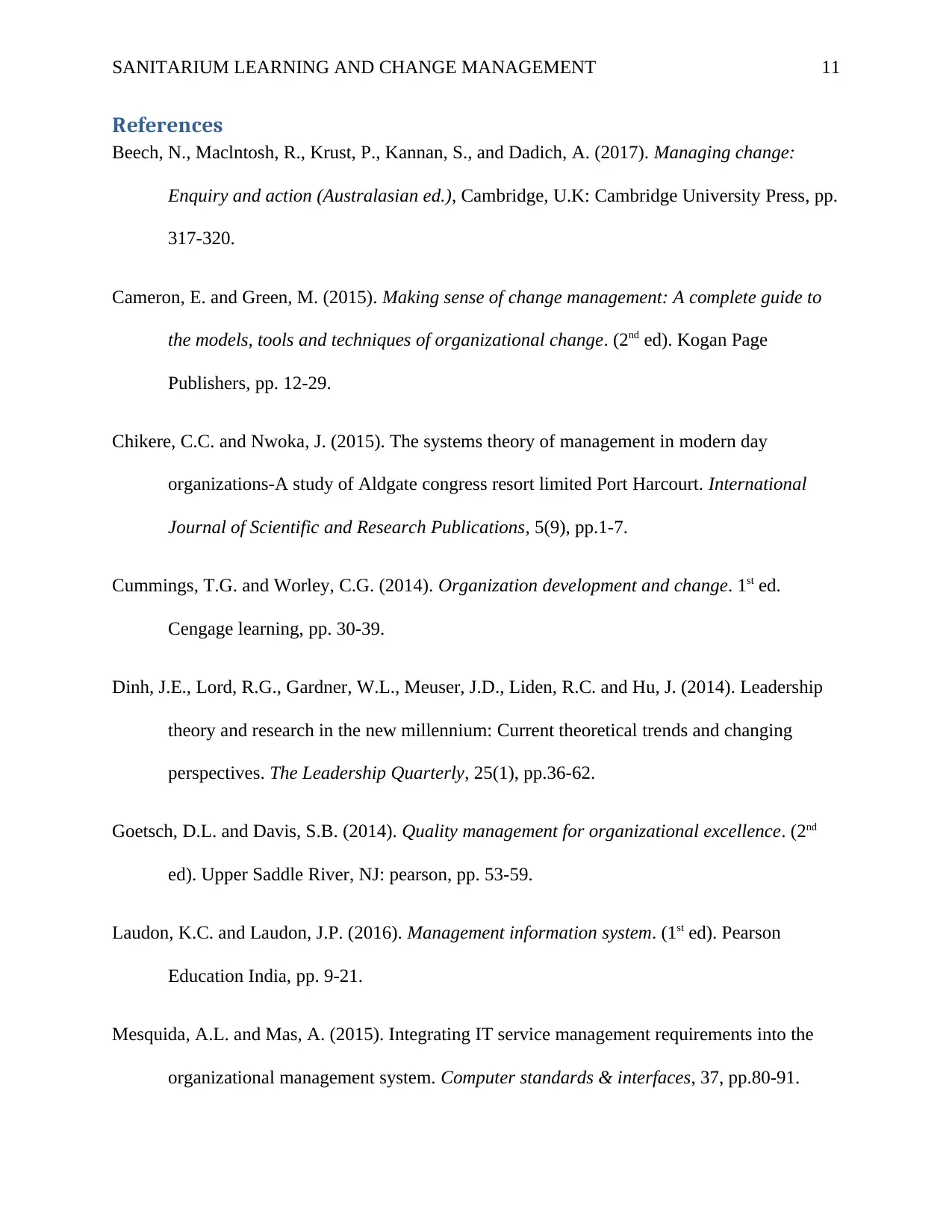
SANITARIUM LEARNING AND CHANGE MANAGEMENT 11
References
Beech, N., Maclntosh, R., Krust, P., Kannan, S., and Dadich, A. (2017). Managing change:
Enquiry and action (Australasian ed.), Cambridge, U.K: Cambridge University Press, pp.
317-320.
Cameron, E. and Green, M. (2015). Making sense of change management: A complete guide to
the models, tools and techniques of organizational change. (2nd ed). Kogan Page
Publishers, pp. 12-29.
Chikere, C.C. and Nwoka, J. (2015). The systems theory of management in modern day
organizations-A study of Aldgate congress resort limited Port Harcourt. International
Journal of Scientific and Research Publications, 5(9), pp.1-7.
Cummings, T.G. and Worley, C.G. (2014). Organization development and change. 1st ed.
Cengage learning, pp. 30-39.
Dinh, J.E., Lord, R.G., Gardner, W.L., Meuser, J.D., Liden, R.C. and Hu, J. (2014). Leadership
theory and research in the new millennium: Current theoretical trends and changing
perspectives. The Leadership Quarterly, 25(1), pp.36-62.
Goetsch, D.L. and Davis, S.B. (2014). Quality management for organizational excellence. (2nd
ed). Upper Saddle River, NJ: pearson, pp. 53-59.
Laudon, K.C. and Laudon, J.P. (2016). Management information system. (1st ed). Pearson
Education India, pp. 9-21.
Mesquida, A.L. and Mas, A. (2015). Integrating IT service management requirements into the
organizational management system. Computer standards & interfaces, 37, pp.80-91.
References
Beech, N., Maclntosh, R., Krust, P., Kannan, S., and Dadich, A. (2017). Managing change:
Enquiry and action (Australasian ed.), Cambridge, U.K: Cambridge University Press, pp.
317-320.
Cameron, E. and Green, M. (2015). Making sense of change management: A complete guide to
the models, tools and techniques of organizational change. (2nd ed). Kogan Page
Publishers, pp. 12-29.
Chikere, C.C. and Nwoka, J. (2015). The systems theory of management in modern day
organizations-A study of Aldgate congress resort limited Port Harcourt. International
Journal of Scientific and Research Publications, 5(9), pp.1-7.
Cummings, T.G. and Worley, C.G. (2014). Organization development and change. 1st ed.
Cengage learning, pp. 30-39.
Dinh, J.E., Lord, R.G., Gardner, W.L., Meuser, J.D., Liden, R.C. and Hu, J. (2014). Leadership
theory and research in the new millennium: Current theoretical trends and changing
perspectives. The Leadership Quarterly, 25(1), pp.36-62.
Goetsch, D.L. and Davis, S.B. (2014). Quality management for organizational excellence. (2nd
ed). Upper Saddle River, NJ: pearson, pp. 53-59.
Laudon, K.C. and Laudon, J.P. (2016). Management information system. (1st ed). Pearson
Education India, pp. 9-21.
Mesquida, A.L. and Mas, A. (2015). Integrating IT service management requirements into the
organizational management system. Computer standards & interfaces, 37, pp.80-91.

SANITARIUM LEARNING AND CHANGE MANAGEMENT 12
Palacios-Marqués, D., Soto-Acosta, P. and Merigó, J.M. (2015). Analyzing the effects of
technological, organizational and competition factors on Web knowledge exchange in
SMEs. Telematics and Informatics, 32(1), pp.23-32.
Palmer, I., Dunford, R. and Akin, G. (2016). Managing organizational change. (1st ed).
McGraw-Hill Education, pp. 17-28.
Ravanfar, M.M. (2015). Analyzing Organizational Structure based on 7s model of McKinsey.
Global Journal of Management and Business Research, pp. 21-32.
Palacios-Marqués, D., Soto-Acosta, P. and Merigó, J.M. (2015). Analyzing the effects of
technological, organizational and competition factors on Web knowledge exchange in
SMEs. Telematics and Informatics, 32(1), pp.23-32.
Palmer, I., Dunford, R. and Akin, G. (2016). Managing organizational change. (1st ed).
McGraw-Hill Education, pp. 17-28.
Ravanfar, M.M. (2015). Analyzing Organizational Structure based on 7s model of McKinsey.
Global Journal of Management and Business Research, pp. 21-32.
⊘ This is a preview!⊘
Do you want full access?
Subscribe today to unlock all pages.

Trusted by 1+ million students worldwide
1 out of 12
Related Documents
Your All-in-One AI-Powered Toolkit for Academic Success.
+13062052269
info@desklib.com
Available 24*7 on WhatsApp / Email
![[object Object]](/_next/static/media/star-bottom.7253800d.svg)
Unlock your academic potential
Copyright © 2020–2025 A2Z Services. All Rights Reserved. Developed and managed by ZUCOL.




